 |
| Ghettos |
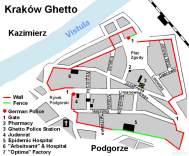 |
| Krakow Ghetto Map |
According to German sources, 68,482 Jews lived in Krakow and the surrounding villages,
in
November 1939. It was one of the largest Jewish communities
in Poland. Most of the Krakow Jews lived in the historical Jewish district
Kazimierz but from
1867, many Jewish families had
lived and had their
own businesses throughout the entire city. Even today one can visit old Jewish houses and the synagogue
in
Kazimierz. It is the only historical Jewish district in a large Polish
conurbation that was not destroyed during the war.
On
6 September 1939, Krakow was captured by German troops. The city became the capital
of the newly established
Generalgouvernement, led by
Generalgouverneur
Hans Frank. He chose the famous
Wawel Castle
as his residence.
Very soon the Nazis ordered all synagogues closed and the establishment of a
Judenrat. The first
president of the
Judenrat was
Marek Biberstein, a well-known
Jewish teacher and social activist.
SS-Oberscharführer Paul Siebert,
who appointed the members of the
Judenrat, told them to fulfil the German orders with absolute
obedience and accuracy. One of the first SS orders was to deliver all valuables
and historical artefacts from Krakow's synagogues.
In
1940 the Jewish ghetto police was established, headed by
Symche Spira.
Before the war he was a carpenter and an Orthodox Jew, who did not speak Polish or
German fluently. He became the best-known collaborator of the SS and
Gestapo.
From
November 1939, all Jews aged 12 years or older had to wear armbands. According
to Jewish sources the
Judenrat sold 53,828 armbands bearing the Star of David.
Jewish homes and shops were looted; SS and
Wehrmacht troops even blocked off entire streets to do this.
The best Jewish apartments were confiscated for German officers' and officials' families.
The houses of the Jewish community were also confiscated. German soldiers moved into
the modern dormitory of the Jewish Academic Society and the old peoples home.
Many young Jewish men were sent to forced labour camps in small towns and villages of
the Krakow district.
In
April 1940,
Hans Frank announced that Krakow should
become the "cleanest" city in the
Generalgouvernement - that is, without Jews. Therefore on
18 May 1940,
the Nazis ordered the resettlement of a large part of the Jewish population. According to this order only
15,000 working Jews were permitted to stay in the town, together with their families.
 |
| Resettlement |
By
15 August 1940, many Jews had been
resettled from Krakow, mainly to towns and
villages around the capital. Because it was intended that even more Krakow Jews should be resettled,
members of the
Judenrat tried to bribe the
Stadthauptmannschaft official who was
responsible for resettlement. Therefore
Marek Biberstein,
several other members of the
Judenrat and the German official were arrested.
Marek Biberstein was imprisoned
in Krakow and
Tarnow until
1942. The Krakow advocate Dr
Artur Rosenzweig
was forced to take over the new leadership of the
Judenrat.
Rosenzweig
was a very modest person who often refused collaboration with the SS. After his release
Marek Biberstein was killed in the
Plaszow forced labour camp in
1944.
In
autumn 1940, the next wave of resettlement occurred. More than 5,000 Krakow Jews
were resettled to the
Lublin district. Others tried to find new homes in the
surroundings of Krakow. By the
end of March 1941, around 41,000 Jews in total
had been resettled.
On
3 March 1941 the governor of the Krakow district, Dr
Otto Wächter,
ordered the establishment of a ghetto in Krakow.
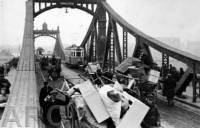 |
| The Big Removal |
The ghetto was not set up in the historical Jewish quarter of
Kazimierz but on
Podgorze.
All Jews who lived in Krakow had to move into the ghetto by
20 March 1941. Some
decided to leave the city, others moved to
Podgorze as ordered. Many Polish
families also had to change
their apartments and take over empty Jewish houses in
Kazimierz. Everywhere
people were on the move, carrying their property, looking for a new dwelling. A Polish witness wrote:
"
We travelled over the Vistula river like many
other families. On one side
of the bridge we came from Podgorze, on the other side the Jews came from
Kazimierz.
I remember the silence of this removal... The silence changed into mourning and sighs."
The ghetto territory covered an area of 20 hectares, and included 15 streets and 320 houses with 3,167 rooms.
A wall in the style of Jewish tombstones and a wooden fence (partially) surrounded
the ghetto.
Otto Wächter's wife described the ghetto wall
as "elegant in the Hebrew taste". All windows and doors overlooking or leading to the "Aryan" side
were to be closed with bricks. Four guarded entrances were created: the main gate
on
Limanowski Street / Podgorski Market, others on
Limanowski Street (only for army vehicles),
Lwowska Street and
Zgoda Square.
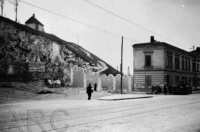 |
| Ghetto Wall |
Most of the houses were old and dilapidated. Before the war, around 3,000 inhabitants
lived in the ghetto area, but now more than 15,000 people were crowded together.
According to the regulations, four families had to share one flat. Alternatively one apartment
window for every three people was allocated. Because of the overcrowded housing, many people spent their time
in the streets. In
October 1941, around 6,000 Jews from surrounding villages
were sent into the ghetto.
Hunger became the biggest problem, since the daily ration of bread for each person was 100 grams,
with an additional 200 grams of sugar or fat provided monthly. The main food was potatoes.
Most of the Jews had to work in ghetto workshops and factories, in part for the German
Wehrmacht or
Luftwaffe.
ID cards were supplied to many Jews.
The first deportation took place
between 30 May and 8 June 1942. Based entirely
on their own judgement,SS-men decided
who would stay in the ghetto and who would be deported.
SS-Hauptsturmführer Wilhelm Kunde was responsible
for this and the next deportation. On
31 May the handing over of ID cards was stopped. All
persons without a card had to gather on
Zgoda Square.
Dr
Artur Rosenzweig organized the assembly, but
he did not want to participate himself in this "action". Jewish policemen, led by
Symche Spira, rounded up the people in their houses and
brought them to
Zgoda Square. During the two first days of this "action"
around 4,000 Jews were deported to
Belzec
death camp. The columns of deportees were led to the
Plaszow Railway Station from
where the overcrowded trains departed to
Belzec. Officially the people were
told that they were going to the Ukraine to work.
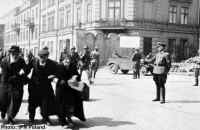 |
| Deportation #1 |
Not enough people were selected for deportation to satisfy the SS. During the next days
of the "action", many Jews were killed on
Zgoda Square or in the streets.
During this time, Dr
Rosenzweig lost his position because of
his "insufficient effort" in organizing the deportation.
Kunde
told him that he would be deported, together with his whole family. The same day he was sent to
Belzec.
Dawid Gutter became his successor.
On
4 June 1942, around 600 people were killed in the ghetto. On the last day
of this "action", 7,000 Jews from
Miechow, Jedrzejow and
Slomniki (villages near Krakow)
were deported, together with Krakow Jews. Among these victims were
Mordechaj Gebirtig, a famous author of Jewish folk songs and
Abraham Neumann, a well-known artist and painter.
Soon after the first deportations many people in the ghetto discussed the fate of their
relatives and comrades. Many Jews believed that the deportees had arrived in the Ukraine,
and were now living in good conditions. But several weeks later, a Pole whose Jewish wife was
deported from Krakow in June, was told by Polish workers that all the people had been deported
to
Belzec. He informed others and the truth went around in the ghetto.
At the
end of June, the ghetto area was reduced.
In August,
Jews from surrounding towns
and villages were concentrated in
Wieliczka, a small town near Krakow. In
late August, many of them were deported to
Belzec.
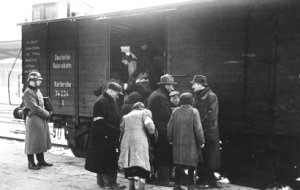 |
| Deportation #2 |
On
28 October 1942, the biggest and most cruel deportation took place in Krakow.
In front of the
Arbeitsamt (job centre) many children were taken away from
their parents. Whole families of employees were selected, although everybody had assumed
that these people were "privileged". Sick people and invalids were killed or deported.
All children from the orphanage were shot near the town, together with their teachers
and curators who voluntarily accompanied them. These "actions" were followed by many suicides.
In the course of this action, around 4,500 Jews were deported to
Belzec and
approximately 600 were killed on the spot. Shortly after this deportation, letters from the
Lwow ghetto were sent to Krakow, informing
the Jews that
Belzec was the deadly terminus of the deportation trains.
In
December 1942, the ghetto was divided into two parts: "Ghetto A" for workers
and "Ghetto B" for non-workers. The latter were to be deported as soon as possible. From
November 1942, many Jews from the ghetto were sent to the SS forced labour camp in
Plaszow, a suburb of Krakow. Among them were the Jews who worked in
Oskar Schindler's enamel factory.
Oskar Schindler
protected his Jewish workers and helped them during the liquidation of the ghetto (see the movie "Schindler's List").
On
13 March 1943, "Ghetto A" was liquidated, and all workers were sent
to
Plaszow
KZ. The action was personally led by
SS-Untersturmführer Amon
Göth, the new commandant of
Plaszow concentration camp.
Prior to this,
Göth
worked in the headquarters of
Aktion Reinhard as
Judenreferent (personal assistant in
Globocnik's office) until
early 1943.
Because of a personal conflict with
Hermann Höfle and his having been accused of corruption,
Globocnik transferred
Göth to Krakow.
On
14 March, the SS liquidated "Ghetto B". Many people were killed in courtyards
or in the streets. The last
remaining Jews were deported in trucks to
Auschwitz-Birkenau.
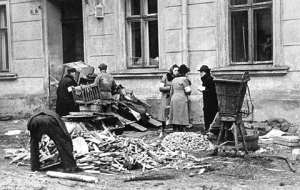 |
| Collecting the Jewish Property |
Columns of Jewish prisoners were led to the ghetto for the collection of Jewish property, left
behind in the houses. This continued until
December 1943. Several weeks
after the liquidation of the ghetto Jewish policemen and the last members of the
Judenrat were sent to
Plaszow.
Dawid
Gutter, head of the
Judenrat,
was executed there in
December 1943, immediately after his arrival in the camp.
Symche Spira was released from
Plaszow at
the request of the
Gestapo, but imprisoned there again in
December 1943.
Spira, the members of the former Jewish ghetto police and their families were
finally executed in
1944, as a result of a personal order of
Göth. That was the last act of the Krakow ghetto tragedy.
In
summer 1942, a Jewish resistance group met in the ghetto. The leaders
were
Adolf Liebeskind, Abraham Lejbowicz, Symek Dränger
and Maniek Eisenstein. Organizing a revolt was impossible, but the group helped
Jews escaping to the forests. The most notable acts of resistance were a bomb attempt
on the German café "Cyganeria" in
December 1942, and the burning of German cars in garages
on
Grzegorzki Street.
After the liquidation of the ghetto and the looting of Jewish property, the houses
at
Podgorze were taken over by poor Polish families. Today, fragments of the
former ghetto wall are still visible, as well as the pharmacy "Under the Eagle" (now containing a small ghetto
museum), which was situated within the ghetto itself. Its owner,
Tadeusz Pankiewicz,
was the only Pole living in the ghetto.
A new
memorial for the murdered Jews of the Podgorze Ghetto was inaugurated on
8 December 2005.
Photos:
Gazeta Wyborcza w Krakowie
GFH
Sources:
Bieberstein: Zaglada Zydow w Krakowie. Krakow 1985.
J. Kast, B. Siegler, P. Zinke: Das Tagebuch der Partisanin Justyna. Jüdischer Widerstand in Krakau. Berlin 1999.
T. Pankiewicz: Apteka w getcie krakowskim. Krakow 2003.
Articles from Krakow newspapers (mostly from the local "Gazeta Wyborcza") published in March 2003 on 60th anniversary
of the liquidation of the Krakow ghetto.
© ARC (http://www.deathcamps.org) 2005



















